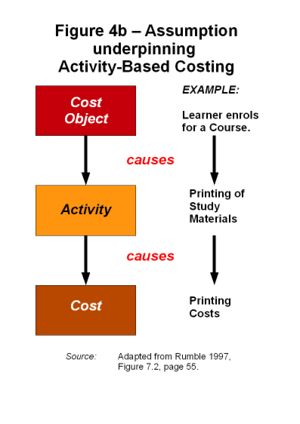Activity-Based Costing
| Unit 4 |
Introduction | Traditional Approach to Assigning Overheads | Critique of Traditional Methods of Cost Accounting | Activity-Based Costing | Steps in Activity-Based Costing | Critique of Activity-Based Costing |
In order to address some of the shortcomings of traditional methods of dealing with overheads, an alternative approach – Activity-Based Costing (ABC) – was developed. The ABC approach can provide more accurate information on where costs arise and how they can be controlled.
The approach to allocating overheads in traditional systems of cost accounting may be characterised as top-down. All indirect expenditure is aggregated centrally and then management decides how it should be apportioned and attached to different products. The assumption underlying this approach is that products cause costs.
The Activity-Based Costing approach turns this assumption on its head. The ABC method is based on the belief that cost objects create a demand for activities, which in turn incur costs (Rumble 1997, page 55). The central assumption of the ABC approach is illustrated in Figure 4b:
In the ABC system, cost objects are the reasons for carrying out activities and may include products, services or customers. An activity is defined as any process or procedure that causes work to be done. Related activities are frequently clustered by function or process into an activity centre. As any productive activity requires labour, materials and equipment, it will incur certain costs.
Some examples of typical activities that would be classified as overheads by conventional cost accounting methods include:
- entering data from application forms on the institution’s computer system,
- advising students about course options,
- following up on queries about non-receipt of materials,
- following up on the reasons why students have withdrawn from courses.
In traditional systems, all of these activities and their associated costs would be lumped together as general overheads for student services.
Rumble (1997, pages 56-57) argues that, without using an activity-based costing approach, no one in the ODL institution knows:
- what these activities actually cost,
- how much they benefit students and thus add value to the service provided,
- how to make the activities more efficient,
- how to attach the costs of these activities to those who actually use them,
- where or when cost reduction will work,
- what savings can be made if student numbers fall.
For all these reasons, he advocates adoption of the ABC approach.
